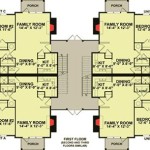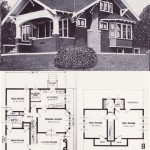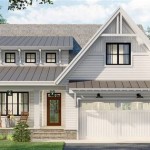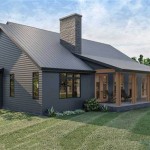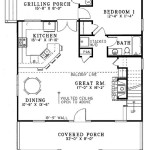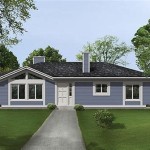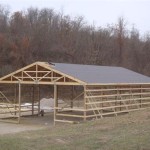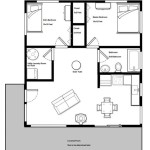Small Passive Solar Home Plans: Harnessing the Sun's Power
Small passive solar home plans are gaining traction as energy costs rise and environmental awareness increases. These designs prioritize harnessing the sun's natural energy for heating, cooling, and lighting, significantly reducing reliance on conventional energy sources. The principles of passive solar design are incorporated into the home's architecture, orientation, and material selection to create a comfortable and energy-efficient living space. For smaller homes, optimizing passive solar strategies becomes even more crucial for achieving significant energy savings and enhancing indoor comfort.
Passive solar design differs from active solar systems, such as photovoltaic panels or solar water heaters, in that it relies on the building's inherent features to capture and distribute solar energy. This approach minimizes the need for mechanical equipment, leading to lower operating costs and reduced environmental impact. Small homes are particularly well-suited to passive solar strategies due to their smaller surface area, which can facilitate efficient heating and cooling. Careful planning and execution are essential to maximize the benefits of passive solar design in small home plans.
Key Principles of Passive Solar Design
Understanding the fundamental principles of passive solar design is essential for creating effective small home plans. These principles center around maximizing solar gain during the heating season, minimizing solar gain during the cooling season, and effectively distributing and storing solar energy within the home.
Solar Orientation: The orientation of the home is paramount for maximizing solar gain. Ideally, the long axis of the house should face south (in the northern hemisphere) to expose the largest surface area to the sun during the winter months. This allows for direct sunlight to penetrate the interior spaces, providing warmth. The overhangs are designed to be able to block the summer sun when it is in a higher position.
Thermal Mass: Thermal mass refers to materials that can absorb, store, and release heat slowly. Common thermal mass materials include concrete, brick, stone, and water. Placing thermal mass strategically within the home allows it to absorb solar energy during the day and release it at night, moderating temperature fluctuations and maintaining a consistent indoor climate. For example, a concrete slab floor exposed to direct sunlight can act as an effective thermal mass element. The placement of thermal mass needs to be carefully considered. If the climate is very hot and heat is retained throughout the night, this thermal mass can actually make the building uncomfortable.
Insulation: Adequate insulation is crucial for retaining absorbed solar heat and preventing heat loss. Well-insulated walls, roofs, and floors minimize heat transfer, reducing the demand for supplemental heating. Insulation also plays a vital role in preventing heat gain during the summer months, keeping the home cool and comfortable. Various insulation materials are available, each with different R-values (a measure of thermal resistance), which should be selected based on the local climate and building codes. Insulation also needs to be continuous to prevent heat loss through thermal bridging.
Glazing: Windows are essential for solar gain, but they also contribute to heat loss and gain. Selecting appropriate glazing materials and window designs is critical for optimizing energy performance. Low-emissivity (Low-E) coatings can reduce heat transfer through windows, while double or triple-pane windows provide enhanced insulation. South-facing windows should be maximized to capture solar energy, while east- and west-facing windows should be minimized to reduce unwanted heat gain during the hottest part of the day. Strategically placed windows that can open or vent are also important. Operable windows can allow the building to breathe and bring in cool night air in warmer months.
Natural Ventilation: Natural ventilation techniques, such as cross-ventilation and stack ventilation, can help to cool the home during the summer months. Cross-ventilation involves strategically placing windows and doors to allow air to flow through the building, removing heat and humidity. Stack ventilation utilizes the principle that warm air rises, creating a natural upward airflow that draws cooler air into the home. Designing homes to take advantage of prevailing winds and natural convection currents can significantly reduce the need for air conditioning.
Designing Small Passive Solar Homes
Designing a small passive solar home requires careful consideration of several factors, including site analysis, floor plan layout, material selection, and window placement. A detailed site analysis should assess the solar orientation, prevailing winds, and surrounding landscape to optimize the home's performance. The floor plan should be designed to maximize solar gain in winter and minimize heat gain in summer. The building materials chosen should have a high thermal mass, and be durable.
Site Analysis: A comprehensive site analysis is the foundation of effective passive solar design. This analysis should assess the sun's path throughout the year, identifying the angles and intensity of sunlight at different times. It should also identify any obstructions, such as trees or neighboring buildings, that might shade the home. Understanding the prevailing winds is crucial for optimizing natural ventilation strategies. The site's topography, soil characteristics, and local climate conditions should also be considered.
Floor Plan Layout: The floor plan should be designed to maximize solar gain in winter. Living areas and bedrooms, where people spend the most time, should be located on the south side of the house to take advantage of direct sunlight. Less frequently used spaces, such as garages or storage rooms, can be placed on the north side to act as a buffer against cold winds. Open floor plans can facilitate the distribution of solar heat throughout the home. Careful consideration should be given to room layout to ensure that the sun’s rays can penetrate deep inside the home.
Material Selection: Selecting appropriate building materials is essential for maximizing thermal mass and insulation. Materials with high thermal mass, such as concrete, brick, and stone, should be used in areas that receive direct sunlight. Insulation with high R-values should be used in walls, roofs, and floors to minimize heat transfer. The choice of roofing material can also affect the home's energy performance. Light-colored roofs reflect more sunlight, reducing heat gain during the summer months. Also materials should be considered for their life-cycle impacts including toxicity, embodied energy and availability.
Window Placement and Design: Window placement and design are critical for optimizing solar gain and minimizing heat loss. South-facing windows should be maximized to capture solar energy during the winter months. Overhangs or awnings can be used to shade south-facing windows during the summer, preventing unwanted heat gain. East- and west-facing windows should be minimized to reduce heat gain during the hottest part of the day. Windows should be properly sealed and caulked to prevent air leaks. Consider the use of window coverings to enhance privacy, aesthetic appeal, and thermal control. Blackout curtains, for example, can improve insulation by blocking solar radiation.
Landscaping: Landscaping can play a significant role in enhancing a home's passive solar performance. Deciduous trees planted on the south side of the house can provide shade during the summer and allow sunlight to penetrate during the winter. Evergreen trees planted on the north side can act as a windbreak, reducing heat loss. Properly placed vegetation can also help to cool the surrounding area through evapotranspiration. Landscaping should be carefully planned to complement the home's design and optimize its energy performance. Native plants and xeriscaping principles are useful in this regard.
Benefits and Considerations of Small Passive Solar Homes
Small passive solar homes offer numerous benefits, including reduced energy consumption, lower utility bills, enhanced indoor comfort, and a reduced environmental impact. However, designing and building a passive solar home also requires careful planning, attention to detail, and a thorough understanding of passive solar principles. Certain climate limitations or initial construction costs may be factors that must be considered.
Reduced Energy Consumption and Lower Utility Bills: By harnessing the sun's natural energy, passive solar homes can significantly reduce reliance on conventional energy sources. This leads to lower utility bills and reduced energy consumption. The savings can be substantial, especially in climates with long heating or cooling seasons. Over time, the initial investment in passive solar design can be offset by the reduced energy costs.
Enhanced Indoor Comfort: Passive solar design creates a more comfortable and healthy indoor environment. By moderating temperature fluctuations and providing natural light, passive solar homes offer a more balanced and consistent indoor climate. Proper ventilation and air filtration can further improve indoor air quality. These homes can also be beneficial for individuals with sensitivities to artificial light or temperature changes. The natural light is also easier on the eyes and the skin.
Reduced Environmental Impact: By reducing reliance on fossil fuels, passive solar homes contribute to a cleaner environment. Lower energy consumption translates to reduced greenhouse gas emissions and a smaller carbon footprint. Passive solar design also promotes sustainable building practices and reduces the demand for non-renewable resources. Using locally source material is also important. These factors make these homes more environmentally friendly than conventional buildings.
Design and Construction Costs: Designing and building a passive solar home may involve higher initial costs compared to conventional construction. This is due to the need for careful planning, site analysis, and selection of appropriate building materials. However, these costs can be offset by the long-term energy savings and reduced operating expenses. The cost of quality windows and high-performance insulation can be a significant factor. Careful cost analysis and value engineering can help to minimize the initial investment.
Climate Limitations: Passive solar design is most effective in climates with ample sunshine and moderate temperature variations. In climates with extreme temperatures or limited sunlight, additional measures may be needed to supplement passive solar strategies. For example, in very cold climates, supplemental heating systems may be required to maintain comfortable indoor temperatures. In very hot climates, shading and ventilation strategies must be carefully designed to prevent overheating. Despite these challenges, careful planning and adaptation can make passive solar design effective in a wide range of climates.
Maintenance and Operation: Passive solar homes typically require minimal maintenance and operation. However, it's important to maintain the building envelope and ensure that windows and doors are properly sealed. Overhangs and shading devices should be inspected and maintained to ensure their effectiveness. Landscaping should be properly managed to avoid shading south-facing windows during the winter months. Regular maintenance and operation can ensure that the home continues to perform optimally over time. Homeowners may also benefit from learning how to optimize their use of natural ventilation and shading strategies.

Passive Solar 1600 0060

10 Solar Passive Houses Ideas House Plans

Affordable Passive Solar Planbook Appalachian Energy Center

Passive Solar House Design Ecoliv

Passive Solar House Plan 2 Bedrms Baths 1418 Sq Ft 146 2710

Deltec Homes Renew Collection Ridgeline B 1604sf Passive Solar Layout Vaulted Ceilings High Clere House Plans Prefabricated Houses Dream

Tiny Eco House Plans Off The Grid Sustainable Houses

Solar Adobe House Plan 1870

Passive Design Green Home Technology Center

Passive Solar House Design

